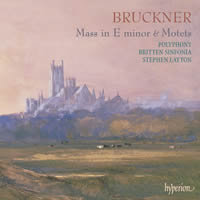Bruckner’s Mass No. 2
|
Walt Mundkowsky [March 2011.]
Anton BRUCKNER: Ave Maria (1861), Locus iste (1869), Mass No. 2 in E minor (1866, rev. 1869, 1876, 1882)1, Christus factus est (1884), Vexilla regis (1892), Os iusti (1879), Virga Jesse floruit (1885), Pange lingua (1868). Polyphony, Britten Sinfonia1, Stephen Layton (cond.). Hyperion CDA67629 (http://www.hyperion-records.co.uk/). Distributed in the US by Harmonia Mundi (http://www.harmoniamundi.com/). This honored 2007 disc is unbeatable of its kind, that being English choral bel canto. In the Mass, Cecilian-inspired modest dimensions and Palestrina counterpoint (the Sanctus cites his Missa brevis) move this Renaissance fan but shouldn’t be overstated; Bruckner’s devotion is everywhere apparent. It’s hard to bring off. Vocal lines are often laid bare and the accompaniments (two each of oboes, clarinets, bassoons and trumpets, four horns and three trombones) require more than mere coordination. (I wonder how the premiere out of doors went.) Seven well-chosen motets bracket the Mass, showing Bruckner’s mastery of short forms and the choir on its own. Layton and his recording team get proportions in the Mass as right as anyone’s. Verbiage about “beauty of tone” falls short of the experience — check samples on Hyperion’s site for a hint of what awaits. Bernius (1992 Sony, O/P) seems more innately Brucknerian, on an intimate scale. (ArkivMusic markets a dub.) The veteran director (b. 1947) also made top-flight Schütz in this period and Zelenka masses more recently. I thought Herreweghe (HM) would be ideally suited, but he’s rather brisk (36:08 to Bernius’ 38:36) and distant. With its occasionally iffy intonation, Jochum’s (DG, 43:19) didn’t sound great even in 1971.
[More Walt Mundkowsky]
[More
Bruckner]
[Previous Article:
Armchair Operas 7.]
[Next Article:
Maestro di Suoni e Silenzi: Necessary Nono 1.]
|
